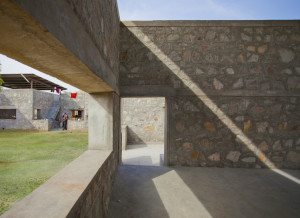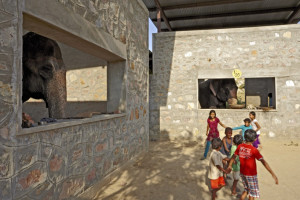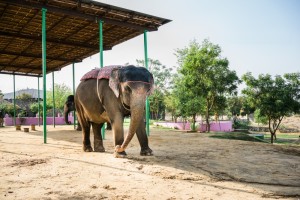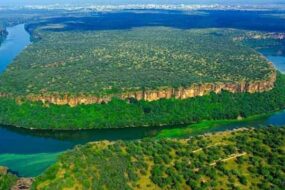India’s first elephant village, launched in 2010 to attract tourists, is in a sorry state now. The project for more than 100 elephants and their mahouts aimed at providing a natural park-like shelter for jumbos with plantations and creating attractions for tourists. Visitors can ascend the sinuous road to Amber Fort, Jaipur by car, foot, or elephant. These last means affords the best vantage point to soak in the grandeur with the slow steps of the elephant. This gigantic animal obeys to one person only, its Mahout. The elephant and the mahout are the least thought of beings outside of being used as mediums for entertainment. Hathi Gaon is a project which is designed with the elephant and mahout as the clients. In striking contrast is the case of the captive elephants employed in the tourism sector in Amber, 11 kilometres from Jaipur city, which ferry tourists from the foothills to Amber Fort along with a steep incline in a dry, hot and drought-ridden climatic zone. The natural habitat of the Asian Elephant, identified as tropical and semi-deciduous forests in proximity to a water source. Animal activists have raised concerns over their living conditions for a number of years, taking cognizance of which, the state allotted land to develop an elephant-centric settlement, christened ‘Hathi Gaon’. The challenges of working through the bureaucracy in a project sponsored by the Government and executed by the Public Works Department were overcome by focusing on the landscape and using the precious resource of water as the central instrument around which decisions were facilitated. This was a humbling experience, as clearly the lives of the inhabitants, and what was crucial for their needs, were privileged in the budgets with the investment in architecture being minimal. The intent in the design was to leave room for the inhabitants (both in terms of basic spatial configurations thorough employing open sky private spaces and the minimal finishes) to transform their own homes incrementally and appropriate them through visual transformations over time.
The project focuses on developing housing for the mahouts and their families. Its intended as both a residential complex for 200 and a tourist destination in its own right. Its designed by Rahul Mehrotra Architects. The architect Rahul Mehrotra ensured that certain details that affected the quality of life, such as the infrastructure and design of the water bodies, matched the original plan without compromise. Residential Units. The dwellings are small—200 square feet—and arranged in sets of four, wrapped around communal courtyards. The housing units are organized in clusters and situated on portions of the site that are not used for the landscape regeneration. The elephants are housed in garage-like rooms with exits on the outer, non-courtyard-facing, sides of the buildings. The families can customize their dwellings as they wish, including enclosing the rooftop terrace to add living space.
The architect has focused on creating a tropical environment for the elephants, with the help of water bodies, pathways and forest area. Unlike other architecture projects, this project has landscape as the centre and architecture have evolved around it. focusing on the landscape and using the precious resource of water as the central instrument around which decisions were facilitated Water as a centre. A wetland at the adjoining lower level forms the connection between the plaza and the elevated visitor’s gallery. The water body was a critical component of the design, as it also facilitated the bonding between the mahout and elephant, through the process of bathing.With the water resources in place, an extensive tree plantation program was carried out together with seeding the site to propagate local species – all at an extremely low cost, using local labour and craftspeople. Courtyards and pavilions supplement the otherwise small area of 40 sqm that was allocated in the budget for this essentially low-income housing project. The site planning thus employed a system of clusters to create shared community space at different hierarchies to build a sense of community among the inhabitants.





